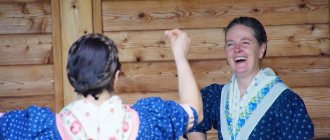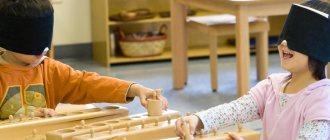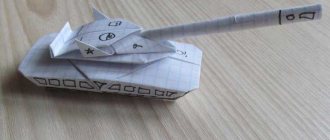Models and types of preschool education. To educators
Models and types of teaching for preschool children
Modern models of preschool education: traditional (authoritarian, educational-disciplinary model) and student-oriented. Traditional: the goal is to equip children with knowledge, skills and abilities (KAS), instill obedience, reproductive activity. The results of preschool education were assessed by the amount of knowledge: it was believed that the more “invested” in the child, the more successfully he was taught.
A distinctive feature of the educational and disciplinary model was the uniformity of content, methods and forms of teaching, i.e. training was carried out according to uniform programs, curricula and manuals. Methods of communication - instructions, explanations, prohibitions, demands, threats, punishments. The teacher’s task is to implement the program and satisfy the requirements of management and regulatory authorities. The child is the object of application of the forces of the educational system. The center of the pedagogical process is frontal forms of work with children, the class-lesson system, children’s activity is suppressed, play is strictly regulated and infringed. Results: mutual alienation of adults and children, loss of initiative by children, negativism.
The urgent need of modern society for people with independent, creative thinking prompted scientists (S.A. Amonashvili, V.V. Davydov, V.A. Petrovsky, etc.) to develop a different learning model based on personality-oriented interaction between the teacher and the child . The purpose of such training is the development of intellectual; spiritual, physical abilities, interests and motives for activities, including educational ones (i.e., the personal development of the child), the acquisition of himself as a unique individuality. To realize this goal, the child, starting from an early age of life, should support the desire to join the world of human culture by mastering the means and methods transmitted to him that are necessary for this inclusion. The teacher needs to organize children and involve them in an active process of solving cognitive and practical problems, during which each child could feel his growth, the joy of creativity and improvement.
The person-oriented model of interaction between a teacher and a child has its own pedagogical technology: the transition from explanation to understanding, from monologue to dialogue, from social control to development, from management to self-government. At the same time, learning is realized in joint activities, cooperation between the teacher and children, in which the teacher is an assistant, adviser, senior friend.
Modern researchers note that the actual educational process in kindergarten involves building a model of personality-oriented interaction between a teacher and a preschool child based on the following positions of its participants:
subject-object model - the adult is in the position of a teacher in relation to children, setting certain tasks for them and offering specific ways and actions to solve them;
object-subject model - an adult creates a developmental environment, a unique objective world in which children act freely and independently;
subject-subject model - the position of equal partners included in a common joint activity.
All presented models take place in the real pedagogical process of a preschool educational institution, and their use depends on the need to solve a variety of educational problems. In this regard, modern works examine various forms of organizing the learning process associated with these positional models and are divided accordingly into three types:
Direct acquaintance of children with the means and ways of knowing or reflecting the surrounding reality.
Direct teaching - the teacher defines a didactic task, sets it for the children, gives a sample of its implementation, and, while completing the task, directs the activity of each child to achieve a result.
Transfer of information from children to adults, when children act independently and an adult observes their activities.
Methods of activity. A problematic situation is created, which the child cannot solve with the help of existing knowledge and skills, including cognitive ones. To do this, he must turn over his experience, establish other connections in it, master new knowledge 3. An equal search by adults and children as subjects of activity for solving a problem during observation, discussion and experimentation.
Indirect learning consists in the fact that the teacher, based on the collected data on the development of children, organizes the subject-material environment: consistently selects certain means with which to optimize the process of mastering new learning skills (books, toys, etc.). Then it is necessary to include these means in children’s activities, enrich their content, and influence the development of communication and business cooperation. (so, the children exchange impressions about where they were in the summer, and the teacher takes out the atlas and visually searches, examines and studies together).
Organization based on the presented models of educational work with children is carried out through the creation of problem-based, developmental, educational situations.
Models of teaching preschoolers
Models of learning. The style of interaction between the teacher and children can be different: authoritarian, democratic and even liberal. Depending on the style, the learning model is formed. If the authoritarian style predominates, then we are talking about an educational and disciplinary model. With the dominance of the democratic style of interaction between the teacher and children, a person-oriented model develops. The listed models differ in goals, objectives, content and teaching methods.
For a long time, the education system, including preschool, was dominated by the educational and disciplinary model, the purpose of which was to equip children with knowledge, skills and abilities. The results of preschool education were assessed by the amount of knowledge: it was believed that the more “invested” in the child, the more successfully he was taught. A distinctive feature of the educational and disciplinary model was the uniformity of content, methods and forms of teaching, i.e. training was carried out according to uniform programs, curricula and manuals.
The urgent need of modern society for people with independent, creative thinking prompted scientists (Sh.A. Amonashvili, V.V. Davydov, V.A. Petrovsky, etc.) to develop a different teaching model based on the student-oriented interaction of the teacher and a child. The purpose of such training is the development of intellectual; spiritual, physical abilities, interests and motives for activities, including educational ones (i.e., the personal development of the child), the acquisition of himself as a unique individuality. To realize this goal, the child, starting from an early age of life, should support the desire to join the world of human culture by mastering the means and methods transmitted to him that are necessary for this inclusion. The teacher needs to organize children and involve them in an active process of solving cognitive and practical problems, during which each child could feel his growth, the joy of creativity and improvement.
The person-oriented model of interaction between a teacher and a child has its own pedagogical technology: the transition from explanation to understanding, from monologue to dialogue, from social control to development, from management to self-government. At the same time, learning is realized in joint activity, cooperation between the teacher and children, in which the teacher is an assistant, adviser, senior friend.
A few more similar articles from our website:
Classes
Mastering the child’s speech, thinking, memory and attention
Article 1, what is a child
Forms of teaching children and their characteristics
Article “Forms of teaching children and their characteristics.
Models and types of training." There are three forms of training organization. 1) individual 2) group 3) frontal 1) The individual form of training contains many positive qualities. The teacher determines the task and content. Methods and means of teaching. These classes cannot become the main form of training. But in some cases, individual lessons are necessary (children who are often ill, restless, excitable). By working with these children, individual education helps them acquire the necessary knowledge and skills. 2) Group form . Classes are conducted with a subgroup (no more than 6 people). Each subgroup should have children with different levels of development (the stronger ones help the younger ones). 3) Frontal classes are conducted with all children. Their content can be activities of an artistic nature, music. knowledge, performance demonstration, acquaintance with works of art. In such classes, the effect of “emotional impact and empathy” is important. The teacher outlines the program content and implements it during the lesson. Types of training. Direct training. The teacher sets a task, gives an example of teaching methods and, in the process of work, guides the child towards the result. Most importantly, the teacher trains children in mastering methods of action. Problem-based learning. The child is not given ready-made knowledge. A problematic situation is created. Children must understand the problem, discuss it with the teacher, solve it - look for solutions. The main method is heuristic conversation, the essence is asking questions. Children give answers based on previously acquired knowledge, a business style develops, and cooperation develops. Indirect learning - through objects, things, etc. Organization by the teacher of the subject-material environment. It creates interest. Intensify the activities of children. These tools are then used in teaching. The purpose of such training is to teach children. obtain knowledge using different sources. Models of learning . In the practice of a teacher, there are 2 types of models: an educational-disciplined model, a personality-oriented one. Academically disciplined. Goal: to equip children with knowledge, skills, abilities, and instill obedience. Methods of communication - instructions, explanations, prohibitions, demands, threats, punishments, notations. Shout. The teacher’s task is to implement the program and satisfy the requirements of management and regulatory authorities. Frontal forms of work with children are carried out. Play as a main activity is limited in time. Result: mutual alienation of adults and children. Personality-oriented. When communicating with children, the teacher adheres to the principle “Not next to and not above, but together!” Goal: to promote the development of the child as an individual. The tasks being solved are: developing the child’s trust in the world, a sense of joy of existence (psychological health), the formation of the beginnings of personality, the development of the child’s individuality. Methods of communication require the ability to take the child’s position, take into account his point of view, and not ignore his feelings and emotions. Communication tactics are cooperation. Viewing the child as a full partner in a cooperative environment. Great importance is attached to the game. The expected results are an expansion of the “degrees of freedom” of the developing child. The personality-oriented model of communication does not imply the abolition of systematic education and upbringing of children, nor does it negate the fact that public preschool education is the first link of the general system of public education.
We recommend watching:
Art therapy in working with children Research activities of children in preschool educational institutions Through fiction - to children's health Organized educational activities with preschool children
Similar articles:
Alphabet in pictures for children
Modern approaches to preschool education
Training in the development of preschool children
Reference
Based on the results of rating municipal educational organizations in the region in 2021, Borisoglebsk kindergartens No. 11, 19 and 20 were recognized as the best preschool institutions. Kindergarten No. 33 became a winner of the All-Russian competition of best practices in inclusive education. Kindergarten No. 182 presented its experience at the VIII International Conference “Early Childhood Education and Education” (ECCE 2019) under the auspices of UNESCO.
In 2021, 23 kindergartens were opened in the Voronezh region. In 2020, 14 kindergartens will be built as part of the regional project “Promoting women’s employment - creating conditions for preschool education for children under three years of age” of the national project “Demography”.
Model of a modern preschool education system
At the present stage of development of society, the preschool education system includes the following blocks, the functioning and development of which are interconnected and interdependent:
- Principles of building preschool education. Currently, the preschool education system is based on the following principles:
- The principle of dynamism. It involves the dynamic development of educational and upbringing processes in accordance with the progress of society and the intensity of its processes;
The principle of variability of organizational forms. It means that preschool educational organizations operating in Russia can be presented in different forms, aimed at meeting various educational needs. At the moment, there are many types of educational institutions and there is variability in the educational services provided;
- The principle of flexibility. It involves a quick response to changes occurring in society, the needs of society for education and the needs of the individual;
- The principle of integrity of the educational process. It is associated with the orientation of educational programs of various types and types towards the development of the personality of each individual child.
- Preschool education programs. They are characterized by the variability of their content and directions of development while focusing on common educational goals and objectives.
- Pedagogical technologies used in the preschool education system. They are related to the implementation of preschool education programs and the implementation of an individual approach to each pupil. Therefore, pedagogical technologies are characterized by variability, flexibility and dynamic use.
- Subject-developing spatial environment. It is a necessary condition for the full development of the younger generation, and therefore, an important component of the preschool education system, without which its full and productive functioning is impossible.
- Teaching staff. The qualifications of modern preschool teachers require their continuous professional growth and development. This is necessary for the implementation of variable educational programs in the preschool educational system and the use of variable pedagogical technologies.
Finished works on a similar topic
Course work Modern system of preschool education 470 ₽ Abstract Modern system of preschool education 240 ₽ Examination Modern system of preschool education 240 ₽
Receive completed work or specialist advice on your educational project Find out the cost
The modern model of preschool education involves the use of variable educational programs that determine the content of the preschool stage of education, the focus of activities, the degree of complexity and guarantee the full and comprehensive development of the younger generation.
The main educational program of a preschool educational institution determines the specifics of building the life activities of children within the walls of a preschool institution, focused on the comprehensive development of each pupil. This is implemented through the inclusion of varied children’s activities in the educational program, presented in the following forms:
- Classes of different directions are a form of educational activity for preschoolers.
- Unregulated types of activity are a form of work that is not included in the regulations of the preschool educational institution.
- Free time – providing children with independent time, socializing in groups, playing and interacting with peers.
At the present stage of development of society, the model of preschool education is based on public-private partnership in the provision of educational services. This means that there are preschool-type educational institutions under the jurisdiction of state authorities, and there are private preschool institutions. Each institution has the right to use its own educational program, adapting to the needs of different families.
Figure 2. Features of modern preschool education. Author24 - online exchange of student work
Types of training teaching aid (junior group) on the topic
Plan
1 Direct training.
2. Problem-based learning.
3. Indirect learning.
The main responsibility of the teacher is to organize children and involve them in the active process of solving cognitive and practical problems, during which students feel their growth, the joy of creativity, and improvement. The personality-oriented model has its own pedagogical technology: the transition from explanation to understanding, from monologue to dialogue, from social control to development, from management to self-government. Learning is realized in joint activities, cooperation between the teacher and children, in which the teacher is an assistant, adviser, senior friend. It is necessary to take into account that any teaching model, including such a progressive one as the student-oriented one, is studied by scientists, and is implemented and put into practice by a teacher in a particular institution in the process of interaction with students. The teacher is the main person in transforming the learning process on a humanistic basis.
In didactics, different types of learning have developed: direct, problem-based, indirect.
1 Direct training.
Direct teaching assumes that the teacher defines a didactic task and sets it for the children (we will learn to draw a tree; compose a story based on the picture that lies in front of each of you). Next he gives an example of ways to complete the task (how to draw a tree, how to write a story).
Conclusion: - during the lesson, the teacher directs the activities of each child to achieve results. To do this, he trains children in mastering the methods and actions necessary to complete a task and acquire new knowledge.
2. Problem-based learning.
Problem-based learning lies in the fact that children are not given ready-made knowledge and are not offered methods of activity. A problematic situation is created, which the child cannot solve with the help of existing knowledge and skills, including cognitive ones. To do this, he must “reverse” his experience, establish new connections in it, and acquire new knowledge and skills. In problem-based learning, children can understand a problematic situation and resolve it in dialogue with each other and the teacher, who directs the search in the right direction, in joint thinking. Collective search activity is a chain of thought and action going from the teacher to the children, from one child to another. Solving a problem situation is the result of teamwork. Research (I. Ya. Lerner, N. N. Poddyakov, L. A. Paramonova, etc.) emphasizes the special role of problem-based learning in the development of children’s mental activity and their creative powers. “Thinking,” writes S. L. Rubinstein, “usually begins with a problem or question, with surprise or bewilderment, with a contradiction. This problematic situation determines the involvement of the individual in the thought process; it is always aimed at solving some problem.” The moral aspect of problem-based learning is obvious: together they “discovered,” for example, why the glass “cryed” in the dressing room when they ran there, caught in the area by sudden rain. The thought of one child (the glass fogged up from steam) continued the guess of the other children (where did the steam come from in the room - maybe from our wet clothes?; why did only the glass become wet?). Children freely express their thoughts, doubts, follow the answers of their comrades, argue or agree. A certain style of business cooperation is emerging, based on a dialogue of equal partners (T.A. Kulikova). The teacher’s task is to lead a complex ensemble, where every child can be a soloist. He involves children in a joint mental search and provides assistance in the form of instructions, explanations, and questions. Cognitive activity is accompanied by a heuristic conversation, during which the teacher poses questions that encourage children, based on observations and previously acquired knowledge, to compare, juxtapose individual facts, and then come to conclusions through reasoning. The main driving force behind problem-based learning is the system of questions and tasks that are offered to children. The most effective questions are, first of all, those that require establishing the similarities and differences between objects and phenomena. A special place is occupied by problematic issues that encourage us to reveal the contradiction between established ideas and newly acquired knowledge. Questions that activate children’s imaginative thinking and imagination are valuable.
Conclusion: - given the important role of problem-based learning in activating the mental activity of children, in the development of cooperative relationships between them, we can talk about its advantages over direct teaching. However, one should also remember the “weaknesses” of problem-based learning. First of all, it can be difficult for a teacher to determine the degree of difficulty of a problem situation for children in a group (subgroup). For some, everything about this problem may be clear, known from past experience, while others, on the contrary, “do not see” what it is, have not yet “grown up” to it. Therefore, it is important to select a search group of no more than 5-6 people with an “equal start”. Also, problem-based learning requires a lot of time and reduces the information capacity of classes. Taking these circumstances into account, problem-based learning should not be considered the only type of learning: it is advisable to combine it with direct and indirect learning.
3. Indirect learning.
The essence of indirect learning is that the teacher studies the level of training and education of children, knows their interests; observes development trends, sees the slightest sprouts of something new in the child, something that is just hatching.
Based on the collected data on the development of children, the teacher organizes the subject-material environment: consistently selects certain means with the help of which the process of mastering new knowledge and skills can be optimized, and interests that have arisen can be strengthened. These can be books, games, toys, plants, equipment for experiments, utensils, etc. Next, it is necessary to include these tools in children’s activities, enrich their content, and influence the development of communication and business cooperation. For example, the children of the older group returned after a summer holiday, some of them visited other cities and countries. Children exchange impressions, but their knowledge is fragmentary, although it has a bright emotional coloring. The teacher shows the book - an atlas for preschoolers, explains its features, and together with the children looks for cities and countries where they have visited. Next, he organizes an examination of the atlas, encourages students to “read conventional signs” (sights, industry, flora and fauna). “Discovering the meaning” of symbols encourages travelers to write coherent stories about their summer trips. Their stories are of interest to other children, who are also in a hurry to share their personal impressions of their vacation. It turns out that there are different countries, cities, holiday villages, villages. And this is the basis for enriching the subject-material environment with new objects through which indirect learning is organized: paintings and pictures, videos about rural life, work, about different landscapes, bodies of water (seas, oceans, rivers, lakes, ponds), etc. . As a result of such training, preschoolers acquire basic geographical knowledge; their cognitive interests expand, cooperation between children develops. With indirect learning, the motto becomes “If you learn yourself, teach someone else.” Therefore, it is important to create conditions through which children can demonstrate their competence in this or that matter, tell others about what they know, and teach what they can do. A child is especially inspired if a teacher turns to him for help: “Seryozha, when I was little, I knew how to play chess a little. Help me remember how to place the pieces and how they move.” The teacher as a student. Agree that this is not a common occurrence, so other children become not only spectators in the “chess school”, but also active participants: they remember the names of the pieces, their location on the board, methods of movement, exchange opinions, ask questions, and empathize with the players. And in the evening they will proudly tell their parents: “I know all the chess pieces! I learned it myself!”; “I learned to ride a horse!”
Conclusion: - the meaning of indirect learning is that the teacher teaches children to use different means to understand the world around them, puts the child in the position of teaching others, i.e. actively promotes mutual learning and self-learning of students. Managing mediated learning requires the teacher to be able to predict the pedagogical process, flexibility, and mobility of behavior.




